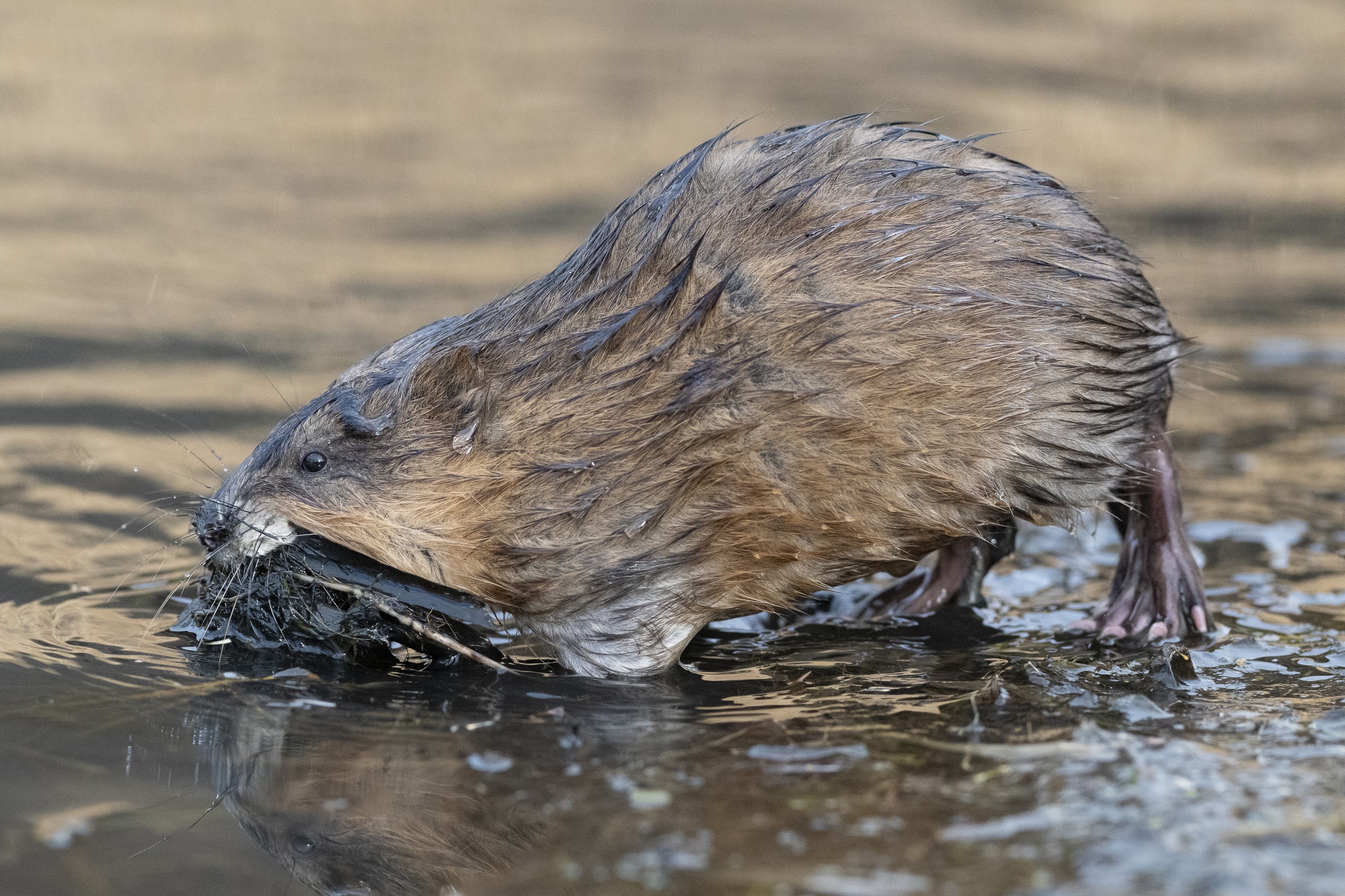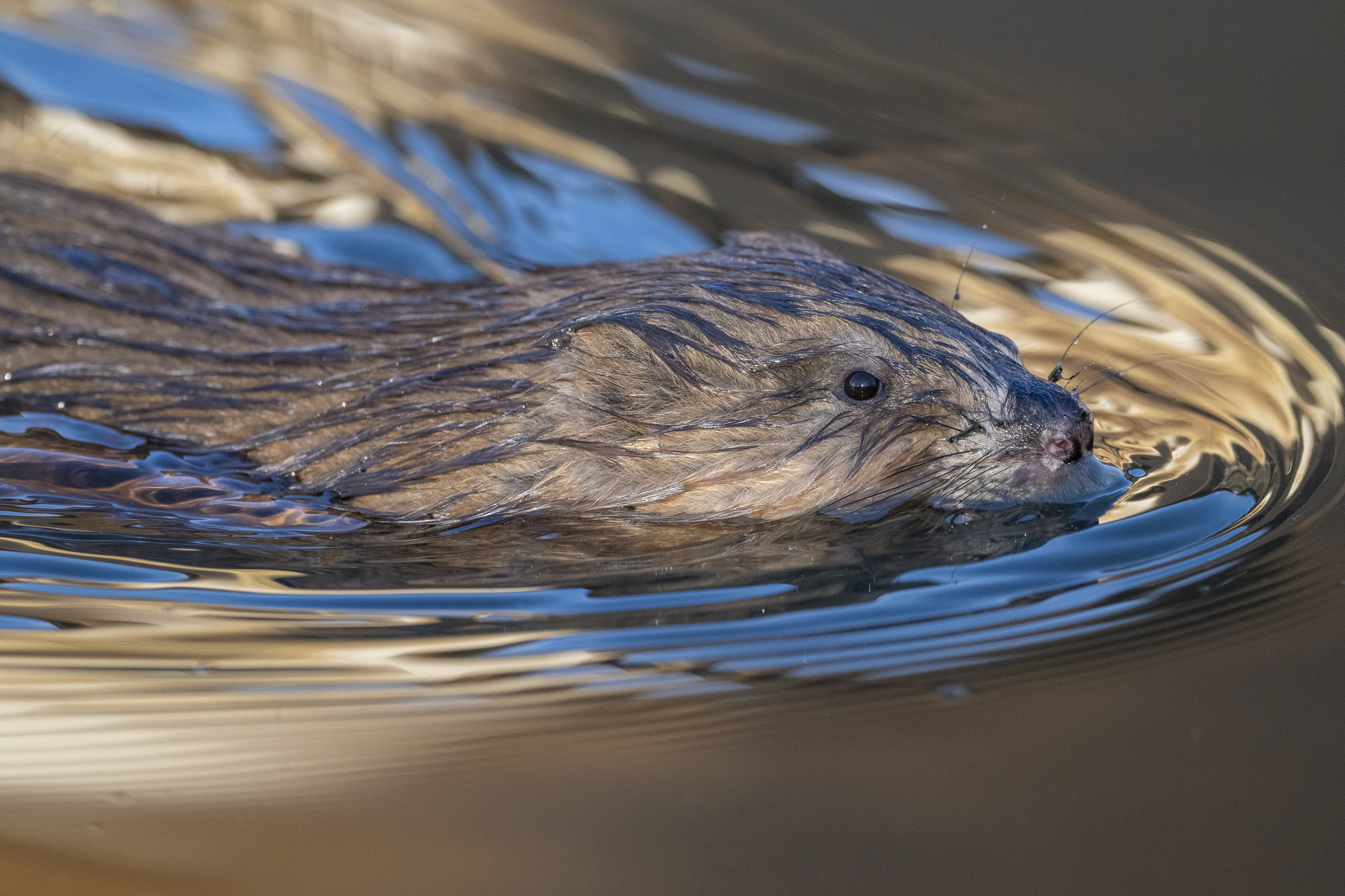I Smell a Rat!
Let’s get one thing out of the way right now – muskrats (Ondatra zibethicus) are not rats.
Muskrats and rats are both rodents, but muskrats are actually more closely related to the meadow voles you can see scampering about in Jasper’s wet meadows… Muskrats are in the family Cricetidae, while rats are in the family Muridae… so to use a family analogy, you could say that muskrats are like cousins to rats, rather than siblings.
What’s in a Name? A Muskrat, by Any Other Name, Would Smell as Sweet…
So they’re not rats, but are they musky? In other words do they smell bad? Well, coming from a biologist: a bit, but not so much that you’re going to notice. Like most mammals, muskrats are highly attuned to the world of odours, and they can send a message though smelly gunk produced by a pair of glands at the base of their tails. What they are communicating is mostly ‘stay away’ to other muskrats. Both sexes will produce this ‘musk’ to mark their territories, but during mating season the male’s glands increase in size and their musk output also increases and gets smellier. And they don’t just wage war through their stink; they also engage in actual fights for the hand of those fair muskrat maidens.

So, if they aren’t rats, and they aren’t particularly musky, where did the name come from?
It’s not known for sure, but perhaps from the Algonquin word muscascus, meaning ‘it is red,’ because of their reddish brown fur. Their name may also come from the Abenaki word for muskrats, moskwas. The Abenaki (like several Indigenous groups) credit the moskwas for helping create the continents. Their creation story is that the planet was once all water, and various animals tried to dive to the bottom of the ocean to bring back mud, but only the muskrat succeeded.
A supernatural being (Nanabush is one name) took the muskrat’s mud and placed it on the back of a turtle, which then began growing and became Turtle Island, or what we call North and Central America.
It’s a Lifestyle
Muskrats live an almost entirely aquatic life in freshwater ponds and rivers. Native to North America, but introduced into Eurasia, they are strong swimmers, using their large, powerful back legs and webbed feet to propel them through, or on top of, the water.

Their back legs are so large that on land, they sometimes look like chubby little kangaroos. They mostly eat the leaves, stems and roots of aquatic plants, but will occasionally take critters like crayfish, insects, fish and frogs. Cattails are one of the most popular items on the muskrat menu.
Like their fellow rodents, beavers, muskrats often build lodges out of mud and vegetation in the water. These lodges can be up to three feet tall and will have a dry ‘room’ or two inside—although the entrance is always underwater. Alternatively, they will dig tunnels in the riverbanks or pond edges that can be up to 15 feet long, with a room or two at the end. Muskrats will also build several ‘pushups’—a kind of mini-lodge made of mud and vegetation. These pushups serve as a kind of way-station for winter foraging trips under the ice.
Within these dens or burrows the female muskrats bear their young. They can bear up to six young at a time, and may produce three litters per year. High reproductive rates like these probably contribute to the population cycles that muskrats go through in some parts of their range; every eight or nine years muskrat numbers will peak, followed by a crash.

And what do muskrats do in the depths of winter? Well, they mostly wile away those winter nights below the ice or in their lodges. They don’t hibernate, so they still have to eat. A lot of their favourite foods like cattails are still available to them under the ice, in the form of roots. They have even evolved the ability to close their lips behind their front teeth so that they can bite and chew below the surface without getting a mouthful of water.
Leave it to Beaver
Muskrats often share habitat with that other wet rodent – the beaver. They look similar, and they do similar things, but muskrats are not closely related to beavers. So how do you tell them apart? For one, beavers are much larger than a muskrat. An adult beaver can reach 60 pounds, with the record-holder weighing in at 100 lbs! A big muskrat, on the other hand, is only about five pounds. Telling them apart in the water can be difficult in poor light or at a distance because you may only see the head of a beaver as it glides along the surface of a pond—and that head can look like an entire muskrat! If you see the skinny tail, however, you’ll know you’ve got your muskrat.
The Fur Trade
Muskrats have been a mainstay of the Canadian fur trade for at least 400 years. Millions of muskrats have been trapped over the centuries, and that industry continues today: in 2021 more than 81,000 muskrats were trapped so that we can make hats and coats out of their warm, insulating fur. While this seems like a lot, the consensus seems to be that the trapping industry is not causing big declines. Muskrats high reproductive rate probably has something to do with that. And remember when I said that muskrats don’t smell all that bad? Well, they sure do if you’re skinning one and puncture one of those musk glands—that’s perhaps why the ‘musk’ part of their name stuck.
Do Muskrats Need Some Love?
Ok, I know what you’re thinking. These info tidbits about muskrats are all very well, but what about the 1976 Captain and Tennille hit ‘Muskrat Love’? For those of you who weren’t around in 1976, this was a chart-topping hit in the US and Canada, and it really was about a fictional muskrat couple that was deeply in love. The song even included a keyboard solo that, according to “The Captain” himself, was meant to represent the sounds of muskrats mating. While I usually like to defend the music of my youth, in this case…I cannot.

Muskrats are mostly fine in Canada (except perhaps in the Peace-Athabasca Delta of Wood Buffalo National Park, where long-term changes to water levels have rendered much of their former habitat unusable). In the US however, there have been widespread and drastic declines in muskrats: muskrat populations have declined by at least 50 percent in 34 states. In a few states the decline ha been catastrophic—more than 90 percent.
Researchers have studied numerous possibilities for the cause of these declines. Trapping kills a lot of muskrats but there seems to be a consensus that it isn’t the smoking gun here. Similarly, it seems that disease and pollution are also not dire enough to be the culprits. Although the puzzle has still not been conclusively solved, perhaps the changes to water levels are also at play in the US.
If the ponds and waterways that the muskrats depend on are eliminated, so too are the muskrats. One thing is for sure – muskrats have no problem living near people as long as we supply them plenty of small water bodies to live in.
Perhaps it’s time for us to show the muskrats some love!
Mark Bradley // info@thejasperlocal.com


